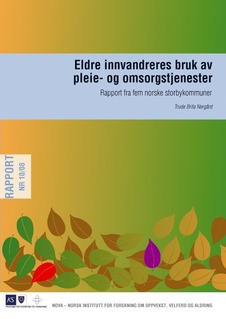| dc.description.abstract | This report comes out of a small research project commissioned to NOVA by the Administration for health and welfare in the Municipality of Oslo, who wanted better documentation on the «needs for care services for the elderly among ethnic minorities in the cities». Here, «ethnic minorities» refer to migrants from non-western countries (i.e. outside Western Europe, North America and Oceania). Included in the project are the five most populous cities in Norway: Oslo, Bergen, Trondheim, Stavanger and Kristiansand. The project was designed to investigate the use elderly from (non-western) ethnic minority groups make of public care services, and also the staff's experiences of giving such services to these clients (by focus group interviews). The five cities represent one fourth of Norway's population (1.1 million), but a much larger share of the immigrant population. However, about18 000 people above the age of 50 live in these five cities (which is half of all immigrants in Norway of that age). More than 600 of these are above 80 years of age. Only in Oslo can immigrants above 80 years be counted in hundreds (more exactly there were 445 in January, 2007). In the other four cities, immigrants within this age group can only be counted in a few tens. Moreover, elderly non-western immigrants make up an even smaller proportion of the recipients of public care services - various home services as well and institutional services. In Oslo, they constituted (in October, 2006) only one per cent of the institutionalized population, and in the other municipalities only one half of a per cent. The data are not sufficient to declare whether or not there has been a change in the use of care services for elderly non-western immigrants over the last two years. These immigrants make relatively more use of home services than they do of institutional places, but also in the home service sector they constitute a small minority. In the four cities outside Oslo, home services rarely serve more than one, two of three non-western elderly immigrants. Only in districts in Oslo with a long term and considerable non-western immigrant population, the number of such care receivers (aged 50 and more) is noticeable (in the municipal district of «Old Oslo» they constitute 16 per cent). According to the focus group interviews, non-western immigrant users of care services represent more of a challenge for care personnel irrespective of their age, than do other users. Poor mastery of the Norwegian language, different cultural experience and practice, including different family relations and compositions; all demand serious adjustments of public services. On the other hand, personnel in care services, and particularly in institutional care, are more multi-culturally mixed than elderly care receivers. Nevertheless, non-western care workers make up a minority, and attempts to match care givers and care receivers in terms of common ethnic or language background are difficult to organize. Neither are such attempts necessarily successful, reported the municipalities which have tried out such «matching». One reason is that some care receivers tend to expect extra services from care givers who also are «countrymen». Personnel of home services reported that they sometimes experienced problems in getting access to non-western families. Also, many such families preferred care wage (cash payment) in stead of services. In all five cities the demand for care wage was increasing. Personnel emphasize the goal of «reciprocal respects» between care receivers and care givers, and they wish they had more courage to stand up against demands from care receivers. But they also emphasize that written information about the services and a service declaration available in many languageswouldmakeiteasiertoreach this goal. Is the take-up of care services for the elderly in this group too low? The fact that few elderly people of non-western background use public care services could be interpreted in this direction, but it could also be a result of the demographic composition on non-western elderly: Due to the recent nature of immigration to Norway, non-western immigrants make up a young population: There are very few above the age of 80 (which is used as a threshold age-value when demand for services for the elderly is estimated). Our present data are not good enough to calculate a possible low up-take. To do so, one would need another similar study, for instance, in five years time. | en |
| dc.description.abstract | Rapporten dokumenterer bruk av pleie- og omsorgstjenester blant «eldre fra etniske minoriteter», samt kommunenes erfaringer med å yte tjenester til disse brukerne. Kommunene som inngår i prosjektet, er Oslo, Bergen, Trondheim, Stavanger og Kristiansand. De representerer en firedel av Norges befolkning og halvparten av innvandrerbefolkningen. Til sammen har de fem kommunene cirka 18 000 innbyggere over 50 år med ikke-vestlig bakgrunn. Vel 600 av disse er 80 år eller eldre. Eldre med ikke-vestlig innvandrerbakgrunn utgjør en svært liten andel av mottakerne i pleie- og omsorgssektoren. Det gjelder hjemmetjenesten så vel som institusjonstjenesten. I Oslo hadde én prosent av beboerne på alders- og sykehjemsinstitusjonene ikke-vestlig bakgrunn (oktober 2006). I de andre kommunene gjaldt det en halv prosent. De ansattes erfaringer med eldre brukere med ikke-vestlig innvandrerbakgrunn er at de - i likhet med etnisk norske brukere - er svært forskjellige og følgelig har ulike behov. Generelt synes det likevel å være en oppfatning blant de ansatte at tjenester til disse brukerne krever mer tilpassing og tilrettelegging enn til andre brukere. En viktig grunn er at få brukere med ikke-vestlig bakgrunn over 50 år behersker norsk. | no_NB |
